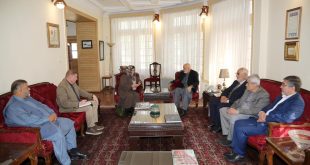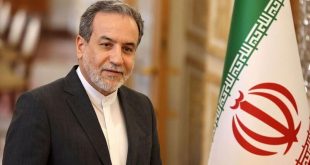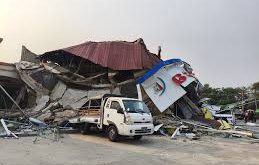Traditionally, the state of Pakistan has an potential enmity with India by birth and a long–term border difference and ethnic tension with Afghanistan. After independence it has fought four declared wars with India without any success. The policy of Islamisation pursued by the regime of Zia-ul-Haq and later governments proceeded from the Sunni Hanafi legal interpretation which predominated in Pakistan. With the strengthening of religious fundamentalism and opening of countless Madrassas in the country, Pakistan’s social composition and nature of the polity began to change in terror d, 0irection. The social and economic conditions also played their role: sectarianism, the phenomenon akin to communalism, sprang out of enmity between religious–political groups. The clashes between Shi’ ites and Sunnis started in the early eighties first in small towns of central and southern Punjab, one of the most backward and poorest parts of the country. Independent Pakistan inherited a border dispute on account of a boundary sketched in 1893 by Sir Mortimer Durand, Foreign Secretary for the British Empire in India. It is now called the Durand Line and runs right through areas inhabited by Pashtuns, splitting them in half. The Afghanistan government does not recognise the line and at the time of partition of India, it had demanded the redrawing of the line. It suggested to make the Indus river as the new border but it was ignored. From then onwards, it has been a constant source of bitterness between Pakistan and Afghanistan.
Outside causes of Pak terrorism
With Russia’s invasion in Afghanistan on 27 December 1979 Kabul became a battleground for the cold war between the United States and the Soviet Union. America and the Soviet Union brought two other neighbours into that cold war fight: Pakistan and India. New Delhi stood by the Soviet Union as it quietly did in many other areas. Pakistan and its intelligence service became the middlemen between the United States and the Mujahideen. It acquired the status of a frontline state in the US–Soviet cold war. Pakistan’s army was used by the US to organise resistance to the pro-Soviet regime in Afghanistan. During the late 1970s and early 1980s, Pakistan’s patronage to hard–line Islamists within the country, the massive recruitment for military and ideological training, and the spread of weapons provided by North Atlantic Treaty Organisation (NATO) countries, created a fertile ground in both Pakistan and Afghanistan for Islamic insurgency in the region. At the time of invasion India called for a withdrawal of Soviet troops, it also expressed its apprehensions about United States military commitments to Pakistan. New Delhi feared that newly acquired United States arms could be used against India, rather than to secure the Afghan border and such fear certainly had a strong base, as in the forthcoming years, these weapons were used by various violent groups to destabilise Punjab, Kashmir and India’s political and social stability.
As a result of crisis in Afghanistan thousands of refugees sought sanctuary in Pakistan from Soviet air raids. Naturally Pakistan became worried as it created troubles for the country in various parts and upset the population balance. The use of Pakistan’s soil by Afghan guerilla organisations and millions of refugees created a law and order problem for the administration. The easy availability of advanced weapons, including rockets, grenades and automatic rifles had helped increase criminal and terrorist activity in Pakistani society. The years between 1977 and 1987 saw a steady inflow of Afghan refugees into Pakistan and the use of Pakistan as a conduit for arms for the Afghan wa* r. In 198।in7, 17ध् ज. per cent of the 832 incidents of international terrorism recorded in the world occurred in Pakistan alone; if Pakistan is excluded, the level of international terrorism actually declined by almost 10 per cent from the level of 1986. The US government blamed Soviet-trained agents of the Afghan intelligence service for carrying out 127 of the 138 international terrorism strikes in Pakistan, leaving 234 people dead and 1,200 wounded. Several terrorist strikes by Iranian and Palestinian agents in Pakistan wer5e reported. True to the proliferation of terrorism it is said that the growth of international terrorist movements should be linked to the willingness of some nations to directly or indirectly sponsor campaigns of terror, often through proxies and other means. State sponsorship of groups has strained relations between India and Pakistan, Pakistan and Afghanistan, and Sri Lanka and India.
Soviet withdrawal and aftereffects
In fact the end of Soviet takeover in Kabul in 1989 was the beginning of the first phase of terrorism and proxy war in Kashmir. Pakistan having failed to wrest Kashmir from India by means of direct armed conflicts in 1947-48, 1965 and 1971, now opted for a low cost proxy war against India, by sponsoring terrorism in Jammu and Kashmir. Pakistan’s involvement in creating and supporting terrorism has been established long ago as India has experienced more terrorist violence than any other country. It was evident from the US House Republican Research Committee which, in its report titled The New Islamist International dated 1 February 1993, quoted, ‘In 1986, with growing experience in training, organising and running the Afghan Mujahideen, and with military supplies available through US, Saudi and other foreign assistance, Pakistan began expanding its operation to sponsor and promote separatism and terrorism, primarily in Kashmir, as a strategic long–term programme. Initially, the emphasis on this programme was on using the Afghan support infrastructure in Pakistan to support Kashmiri militants, Indeed, during the main escalation of Islamist violence in Indian Kashmir in mid-1988, Pakistan provided assistance in the training and arming of Kashmiri terrorists, as well as sanctuaries to Kashmiri insurgents across the border.
Cross–border terrorism has been on the rise in the valley over the years. The porous border, free flowing information and modern means of communication, all have made cross border terrorism an easy game. Under a well- thought policy thousands of Islamist terrorists have been pushed inside Kashmir and to facilitate the infiltration of Islamist mercenaries, Pakistani forces resort to firing at Indian pickets along the LoC, to divert attention and to provide cover to the armed intruders. The Islamist mercenaries have extended their operation from Kashmir to Poonch, Mendhar, Rajouri, Doda, Kishtwar and even made forays into Chamba in Himachal Pradesh. It also seeks to acquire control over the strategic and high altitude areas in Jammu and Kashmir for carrying out its future offensive against the Indian forces. The end result of this was the Kargil aggression of Summer 1999. Even the coming of General Pervez Musharraf to power in October 1999 has not helped matters to any significant extent. One of his first goals after seizing power was to reverse the Talibanisation of Pakistan by clipping the wings of the then flourishing Jihadi organisations. In 1999 and 2000, he tried to make their members stop carrying arms in public, tried to move them out of mainland Pakistan into ‘Azad Kashmir’. Musharraf feared that any change in his country’s Kashmir policy may cost him the very authority he is exercising due to vocal supports some of these groups have in Pakistan.
Breakthrough of 11 September 2001
The continuum of history and geography on the one hand, and the prevailing politico–military ambiance between India and Pakistan on the other that had nurtured this phenomena cannot be compared with any other experience in the world. The event of 11 September 2001 suicidal attacks in the United States brought a rapprochement between Pakistan and the West. Pakistan agreed to co–operate with the US’s campaign against Osama bin Laden’s Al-Qaeda network and the Taliban rulers of Afghanistan. The US response to the attacks confronted the political leaderships of both Pakistan and India with unique challenges and opportunities. Pakistan had to quickly choose whether it would become an adversary of the US and risk the expected consequences, or side with it, and confronts its own Islamic–fundamentalist allies in Pakistan and Afghanistan. It chose to side with the US invasion of Afghanistan. On the other hand, for the first time New Delhi found the opportunity to categorise all Islamist resistance to Indian armed forces in Kashmir as terrorism, and it wanted endorsement for its efforts to crush them and the US did declare multiple Islamist groups to be terrorist organisations.
Author:
Dr. Rajkumar Singh
Professor and Head
P.G.Dept of Pol.Sc.
BNMU, West Campus
P.G.Centre, Saharsa
Bihar, India.
Email- rajkumarsinghpg~yahoo.com
 Afghanistan Times
Afghanistan Times




